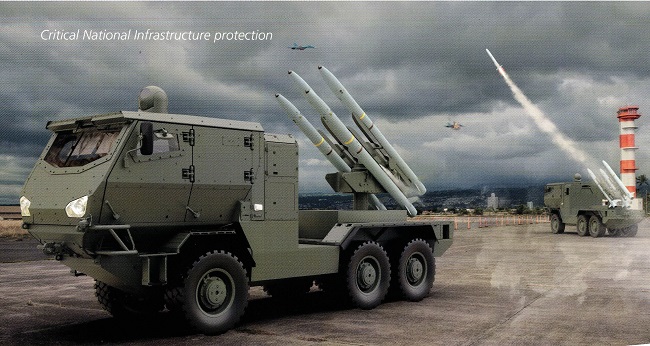
At DSEI 2025, MBDA quietly pushed a proposal for additional and enhanced solutions to launch the AIM-132 ASRAAM from the ground, aimed at rapidly bolstering Ground Based Air Defence and complementing radar-guided solutions.
The UK has notoriously exploited its stockpile of ASRAAM Block 4 air to air missiles, in the process of being superseded by the new Bk 6, to rapidly supply Ukraine with an effective short to medium range surface to air defence system. The first system to be provided has been the RAVEN, a mobile solution provided to Ukraine that mates a Supacat HMT 6-wheeled platform (very possibly specifically vehicles that were originally procured by the British Army under past, cancelled programs including the lightweight mobile artillery weapon system LIMAWS and the SOOTHSAYER electronic warfare system) to an HAWKEYE electro-optic infrared sight by Chess Dynamics and a very simple launcher for 2 ASRAAM obtained repurposing rail pylons of aeronautical origin.

GRAVEHAWK followed: virtually identical in principle, it puts the EO/IR sight and the same kind of 2-missile launcher ramp into a modified 20-foot ISO container. Although it has been conceived specifically to enable the Ukrainian Air Force to repurpose its own short-range, IR-guided missiles for use from land, it is most likely compatible with ASRAAM as well.
MBDA is now pushing for more and more “refined” solutions. Perhaps the most interesting of all, suggested in a CGI image, is the repurposing of the trailer launcher of the RAPIER Field Standard C to employ 8 ASRAAM. This would give new purpose and new value to the system the Royal Artillery has used before SKY SABRE and could be very interesting in terms of supplying Ukraine with further launchers.
The present status of the ex-British Army RAPIER launchers is unclear: RAPIER was last fired on UK soil in late 2020 by 30 Battery, 16 Royal Artillery which subsequently deployed to the Falklands where it operated well into 2021 with the system, ahead of the first arrival of the new SKY SABRE.
RAPIER 2000, better known as “Field Standard C” recognizable for the large EO/IR sensor “ball” on the launch trailer, was also used by several other Nations as well, including Malaysia, Oman, Singapore, Switzerland, and Turkey. A number of launchers could thus be sourced at low cost from a number of different places.
Other options that MBDA is touting include employment on naval craft, including small fast boats and also large warships, implying presumably full vertical launch from enclosed cells. A TheMIS Uncrewed Ground Vehicle-mounted launcher is also displayed, a proposal already formulated earlier for BRIMSTONE.
The adaptation of other vehicles is a possibility, with a concept image showing even an AJAX Common Base hull platform adapted to carry 12 canistered ASRAAM in the back.
A more refined RAVEN, using the newer Supacat HMT600 Enclosed Cab by Supacat and a new and relocated EO/IR turret is shown, with a slightly evolved launcher for 4 missiles or even a double launcher for 8. The same 8-missiles launcher is also shown installed within a container.
With its proven high maneuverability, including the ability to make 180° turns to engage targets “over the shoulder” and its lock-on after launch feature, the ASRAAM is easily adaptable for launch from simple ground platforms and can bring extensive capability at low cost, complementing, in the British Army case, the radar-guided CAMM (itself an ASRAAM derivative) used by SKY SABRE batteries.









.png)
